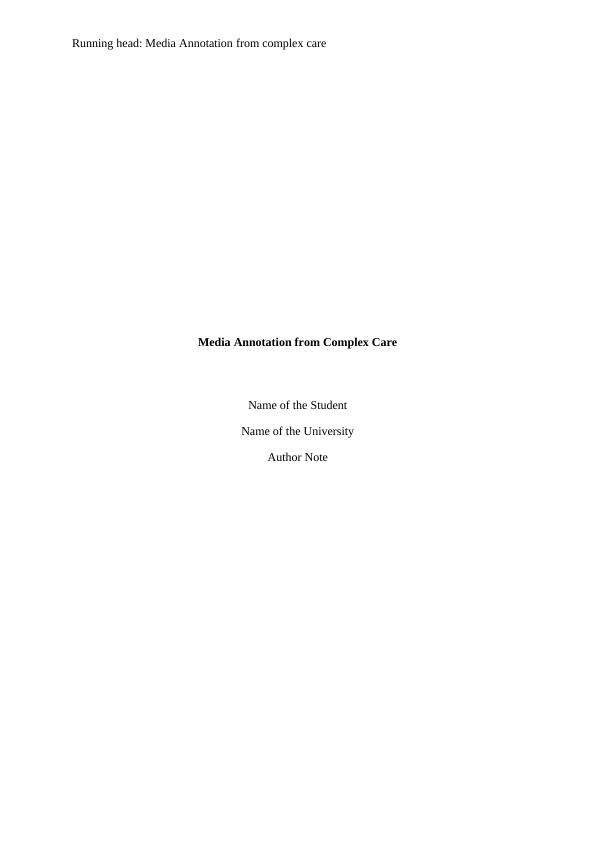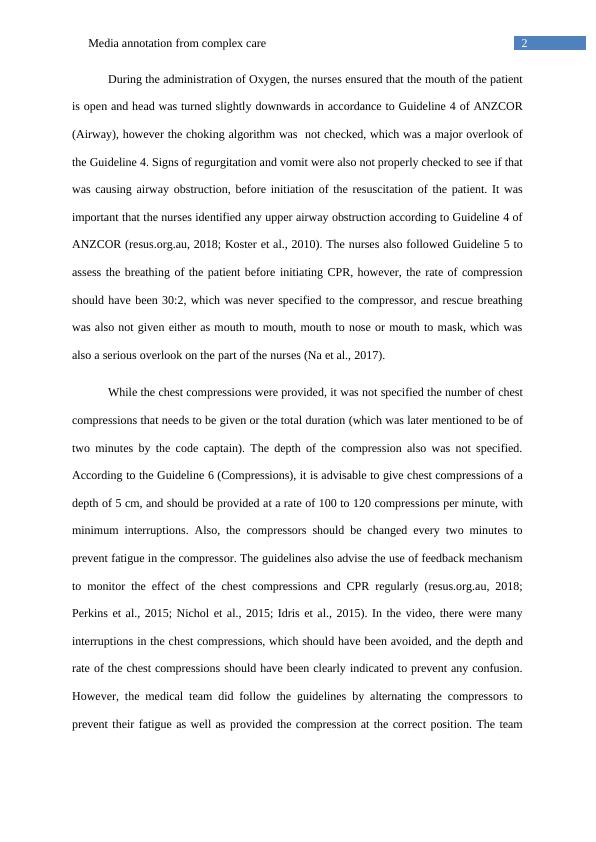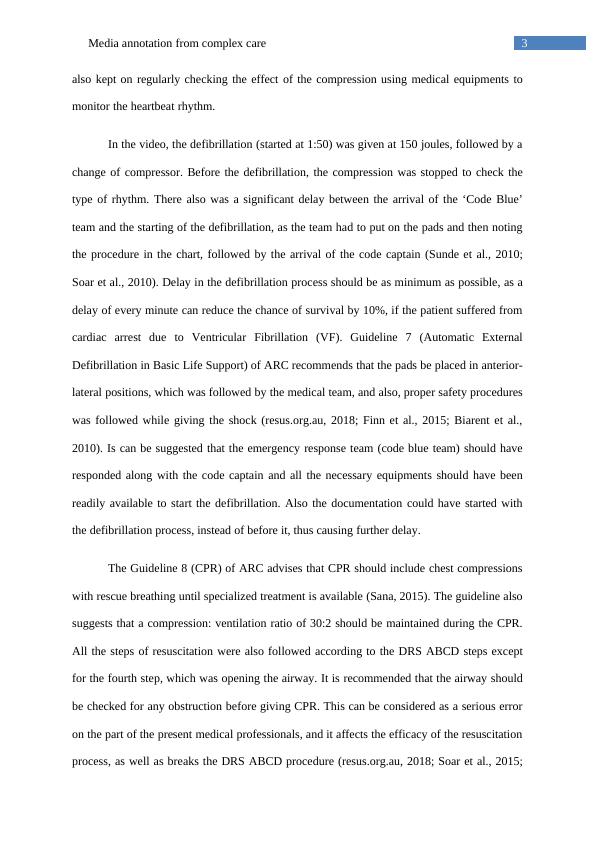Complex Care Media Annotation
Added on 2021-06-17
11 Pages3276 Words29 Views
Running head: Media Annotation from complex careMedia Annotation from Complex CareName of the StudentName of the UniversityAuthor Note

1Media annotation from complex careThe review of the given video scenario on ‘Code Blue, Full code’, it was evident thatthe medical practitioners applied various strategies to resuscitate the unresponsive patient,and eventually able to change the code blue status to normal by restarting the cardiac pulse.The patient was unresponsive at first with no pulse, but after the pulse, regular sinus rhythmwas returned. However a closer look at the video, and an over view of the AustralianResuscitation Council (ANC) showed several aspects of underperformance and misses on theactions outlined in the guidelines. In the following essay, a review of the actions taken by themedical professionals in the given video will be analyzed to identify both the good and badpractices, and outline recommendations which can be followed to ensure better care andcompliance with the guidelines of ANC.At the starting of the video (0:13), the nurse entered the patient’s room and found himunresponsive, and could not find a pulse due to which she initiated a full code blue. Afterabout 20 seconds of that, the code blue was initiated and in another 10 seconds, antibioticswere stopped and normal saline started. The resuscitation equipment arrived after 20 secondsof initiating code blue and the code blue team arrived about 60 seconds after the code wasinitiated. The actions of the nurses was according to the Guideline 2 of ANC (Managing anEmergency) showing prompt action, quick assessment and promptly asking for help. Thepatient was placed in a lateral position lying on the back; however, the position should havebeen lateral side lying recovery position (or lateral recumbent position) as per the ANCguideline, which was missed (Perkins et al., 2015; Hood & Considine, 2015; Zideman et al.,2015). Also, the ANZCOR guidelines was also not followed as the nurses did not monitor theblood saturation of oxygen (sp02), and oxygen was given without monitoring bloodsaturation. The verbal and tactile stimuli of the person were however checked asrecommended in Guideline 3 (Recognition and First Aid management of unconscious person)(resus.org.au, 2018).

2Media annotation from complex careDuring the administration of Oxygen, the nurses ensured that the mouth of the patientis open and head was turned slightly downwards in accordance to Guideline 4 of ANZCOR(Airway), however the choking algorithm was not checked, which was a major overlook ofthe Guideline 4. Signs of regurgitation and vomit were also not properly checked to see if thatwas causing airway obstruction, before initiation of the resuscitation of the patient. It wasimportant that the nurses identified any upper airway obstruction according to Guideline 4 ofANZCOR (resus.org.au, 2018; Koster et al., 2010). The nurses also followed Guideline 5 toassess the breathing of the patient before initiating CPR, however, the rate of compressionshould have been 30:2, which was never specified to the compressor, and rescue breathingwas also not given either as mouth to mouth, mouth to nose or mouth to mask, which wasalso a serious overlook on the part of the nurses (Na et al., 2017).While the chest compressions were provided, it was not specified the number of chestcompressions that needs to be given or the total duration (which was later mentioned to be oftwo minutes by the code captain). The depth of the compression also was not specified.According to the Guideline 6 (Compressions), it is advisable to give chest compressions of adepth of 5 cm, and should be provided at a rate of 100 to 120 compressions per minute, withminimum interruptions. Also, the compressors should be changed every two minutes toprevent fatigue in the compressor. The guidelines also advise the use of feedback mechanismto monitor the effect of the chest compressions and CPR regularly (resus.org.au, 2018;Perkins et al., 2015; Nichol et al., 2015; Idris et al., 2015). In the video, there were manyinterruptions in the chest compressions, which should have been avoided, and the depth andrate of the chest compressions should have been clearly indicated to prevent any confusion.However, the medical team did follow the guidelines by alternating the compressors toprevent their fatigue as well as provided the compression at the correct position. The team

3Media annotation from complex carealso kept on regularly checking the effect of the compression using medical equipments tomonitor the heartbeat rhythm. In the video, the defibrillation (started at 1:50) was given at 150 joules, followed by achange of compressor. Before the defibrillation, the compression was stopped to check thetype of rhythm. There also was a significant delay between the arrival of the ‘Code Blue’team and the starting of the defibrillation, as the team had to put on the pads and then notingthe procedure in the chart, followed by the arrival of the code captain (Sunde et al., 2010;Soar et al., 2010). Delay in the defibrillation process should be as minimum as possible, as adelay of every minute can reduce the chance of survival by 10%, if the patient suffered fromcardiac arrest due to Ventricular Fibrillation (VF). Guideline 7 (Automatic ExternalDefibrillation in Basic Life Support) of ARC recommends that the pads be placed in anterior-lateral positions, which was followed by the medical team, and also, proper safety procedureswas followed while giving the shock (resus.org.au, 2018; Finn et al., 2015; Biarent et al.,2010). Is can be suggested that the emergency response team (code blue team) should haveresponded along with the code captain and all the necessary equipments should have beenreadily available to start the defibrillation. Also the documentation could have started withthe defibrillation process, instead of before it, thus causing further delay.The Guideline 8 (CPR) of ARC advises that CPR should include chest compressionswith rescue breathing until specialized treatment is available (Sana, 2015). The guideline alsosuggests that a compression: ventilation ratio of 30:2 should be maintained during the CPR.All the steps of resuscitation were also followed according to the DRS ABCD steps exceptfor the fourth step, which was opening the airway. It is recommended that the airway shouldbe checked for any obstruction before giving CPR. This can be considered as a serious erroron the part of the present medical professionals, and it affects the efficacy of the resuscitationprocess, as well as breaks the DRS ABCD procedure (resus.org.au, 2018; Soar et al., 2015;

End of preview
Want to access all the pages? Upload your documents or become a member.
Related Documents
Analysis of Code Blue Simulation Video: Adherence to ARC and ANZCOR Guidelineslg...
|9
|2754
|307
Evaluation of CPR Technique in a Demonstration Videolg...
|8
|2056
|368
Complex Nursing Carelg...
|9
|2450
|82
Media Annotation: Critical Appraisal of Christiana Care Health System’s Code Blue Simulation Programlg...
|12
|3332
|312
Sample Assignment on Nursing (DOC)lg...
|13
|3857
|123
Review of Code Blue Video Assignment PDFlg...
|10
|3146
|110